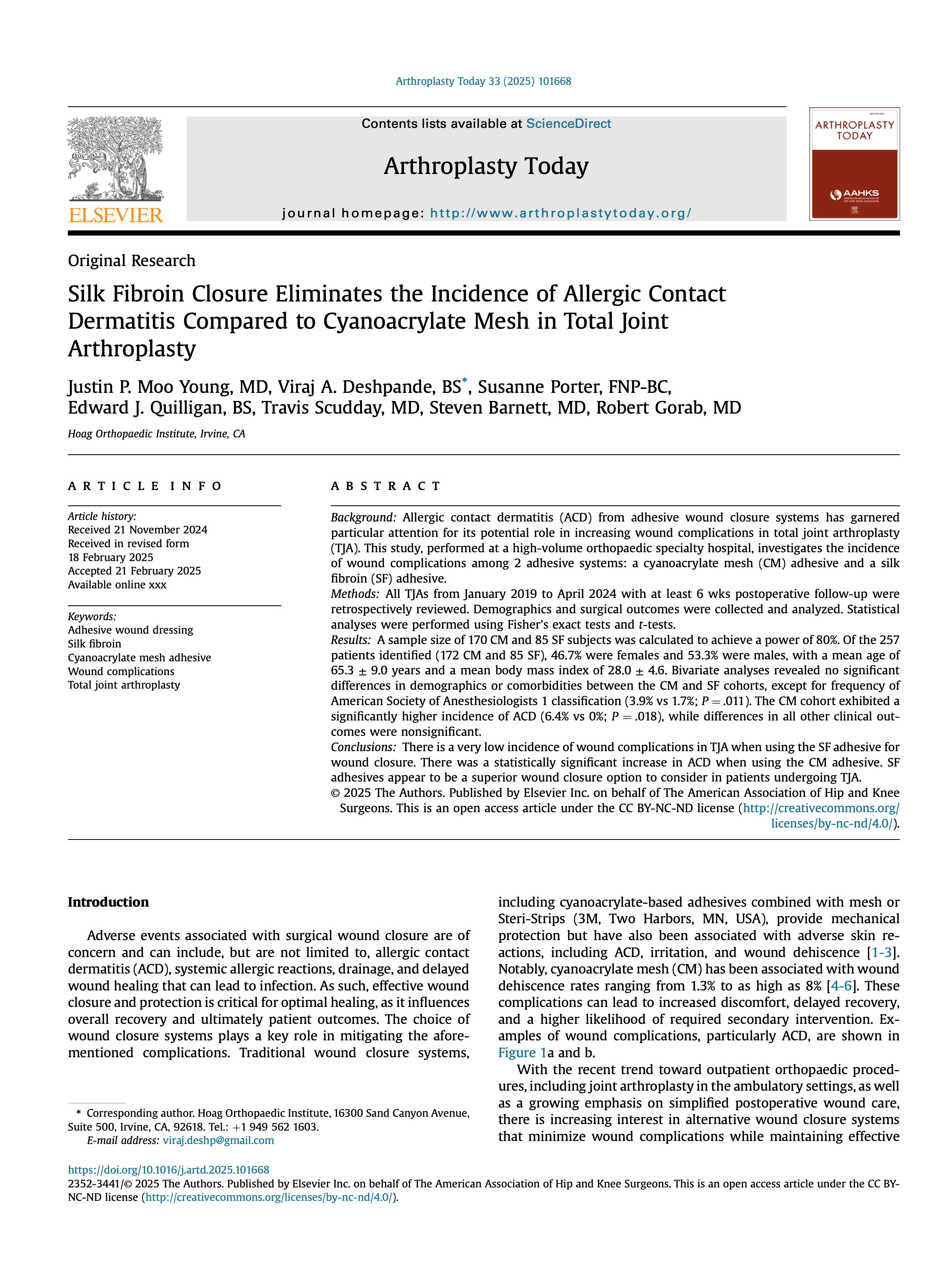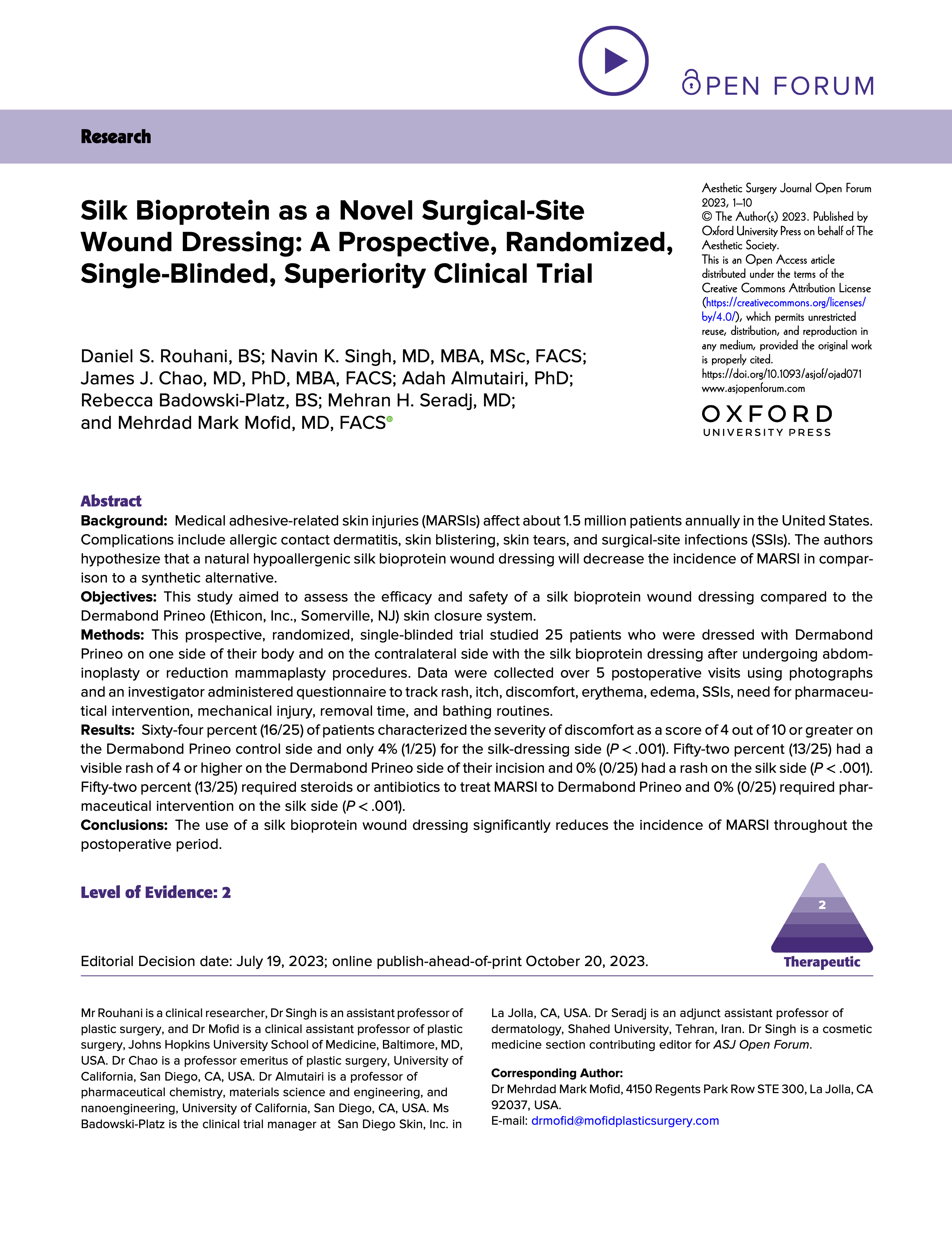Peer-Reviewed Clinical Data

Six Evidence-based Recommendations for Perioperative Incisional Care in Plastic Surgery: A Narrative Review
A Narrative Review
Authors: Rouhani, Daniel S. BS; Zeng, Steven MD; Khoo, Kimberly H. MD, MPH; Ma, Mingxiao; Bishop, Sarah N. MD, FACS; Janis, Jeffrey E. MD, FACS; Mofid, Mehrdad M. MD, FACS
Published: October 27, 2025
Introduction: Perioperative incisional care is essential in plastic surgery for minimizing complications and optimizing outcomes, yet conflicting guidelines from major health organizations, such as the World Health Organization (WHO) [1], the Centers for Disease Control and Prevention (CDC) [2], and the Society for Healthcare Epidemiology of America (SHEA) [3], create variability in clinical practice. A survey of American Society of Plastic Surgeons (ASPS) members highlights this variability, revealing a lack of consensus on best practices incisional care techniques [4]. Further complicating surgical protocols, the FDA’s removal of bacitracin in 2020 due to nephrotoxicity concerns has altered the use of triple antibiotic solution, leading to a shift toward alternative irrigation strategies [5]. Given these ongoing changes and practice inconsistencies, an evidence-based approach to perioperative incisional care in plastic surgery is critical for improving patient safety and surgical outcomes.
Methods: A comprehensive literature search of PubMed, MEDLINE, and Embase (2000–2025) was performed using defined terms (“clean surgical wounds,” “plastic surgery,” “incisional care”). Randomized controlled trials, systematic reviews, and meta-analyses focusing on six key areas-antiseptic preparation, wound irrigation, suture materials, wound closure devices, dressings, and topical agents-were prioritized. Studies pertaining to non-English publications, contaminated wounds, chronic wounds, and animal models were excluded. References were further compared with guidelines from health organizations, including the NIH, WHO, CDC, and ASPS. A narrative review was chosen over a systematic or scoping review to provide a structured synthesis of diverse evidence, integrating various study designs, expert consensus, and clinical guidelines to better inform clinical decision-making in plastic surgery.
Results: Six evidence-based recommendations emerged. First, 4–5% alcohol-based CHG is preferred for preoperative antisepsis. Second, antiseptic solutions (e.g., CHG or PVP-I) are recommended for irrigation over normal saline, and routine antibiotic irrigation is discouraged to mitigate antimicrobial resistance. Third, standard sutures are generally favored over barbed or antimicrobial-coated sutures. Fourth, 2-octyl-cyanoacrylate adhesives pose a high risk of hypersensitivity reactions, while silk fibroin strips offer improved biocompatibility and paper tapes remain useful for low-tension incisions. Fifth, traditional dressings remain adequate for most clean wounds, while closed-incision negative pressure wound therapy (ciNPWT) and silver dressings may benefit chronic wounds. Sixth, plain petrolatum is a safe topical agent, as antibiotic ointments confer no additional benefit and increase antibiotic resistance risks.
Conclusions: This narrative review synthesizes current evidence to offer six actionable, perioperative recommendations tailored to Class 1 clean incisions in plastic surgery. By synthesizing current evidence, this review serves as a comprehensive resource to guide clinical decision-making and optimize surgical outcomes for plastic surgeons.
Read The Study →

Silk Fibroin Wound Dressing Significantly Decreases Hypersensitivity Compared to 2-Octyl Cyanoacrylate Mesh Dressing
Retrospective Cohort Study
Authors: Klara I.M. Aastroem, BS; Nana O. Sarpong, MD MBA; Alexander L. Neuwirth, MD; H. John Cooper, MD; Jeffrey A. Geller, MD; Roshan P. Shah, MD JD
Published: June 24, 2025
Background: Mesh dressings sealed with 2-octyl cyanoacrylate have been associated with hypersensitivity following total joint arthroplasty (TJA). Silk fibroin is a biopolymer available as a novel adhesive woven dressing that does not require skin glue and allows permeability. The purpose of this study was to compare hypersensitivity, delayed wound healing, wound edge separation, reoperations within 90 days, dressing application time, and cost differences between silk dressings and 2-octyl cyanoacrylate mesh dressings.
Methods: We reviewed 261 consecutive patients who received either silk or mesh dressings for the incidence of hypersensitivity, delayed wound healing, wound edge separation, reoperations, dressing application time, and cost after TJA. Silk fibroin dressings were used in 58 patients, while 2-octyl cyanoacrylate mesh dressings were used in 203 patients. Statistical analyses were performed using independent t-tests, χ² tests, two-sided Fisher’s exact tests, and multivariate logistic regressions.
Results: The silk group had a lower rate of hypersensitivity (0 vs 9.9%, P = 0.009). We observed delayed wound healing associated with hypersensitivity in 1% of mesh patients. There were no cases of wound edge separation in knee cases in either group. There were no differences in reoperations. With silk dressings, the total average cost savings were $465.91 per case, comprising $327.34 in dressing cost savings and $138.57 in operating-room cost savings, with an average of 3.7 minutes of operating-room time saved.
Conclusions: Silk fibroin dressing was associated with less hypersensitivity and shorter application time compared to 2-octyl cyanoacrylate mesh dressings, with no cases of wound edge separation upon removing the silk dressing, even with early knee-motion protocols. Although direct costs vary with institutional pricing, substantial savings were observed with the silk dressing, and eliminating glue-drying time saved an average of 3.7 minutes, which can be impactful in health systems lacking parallel-processing efficiencies.

Silk Fibroin Closure Eliminates the Incidence of Allergic Contact Dermatitis Compared to Cyanoacrylate Mesh in Total Joint Arthroplasty
Retrospective Cohort Study
Authors: Justin P. Moo Young, MD; Viraj A. Deshpande, BS; Susanne Porter, FNP-BC; Edward J. Quilligan, BS; Travis Scudday, MD; Steven Barnett, MD; Robert Gorab, MD
Published: March 24, 2025
Background: Allergic contact dermatitis (ACD) from adhesive wound-closure systems can increase postoperative complications after total joint arthroplasty (TJA). This high-volume orthopaedic-hospital study compared wound complications between a cyanoacrylate mesh (CM) adhesive and a silk fibroin (SF) adhesive.
Methods: All TJAs from January 2019 to April 2024 with ≥6 weeks of postoperative follow-up were retrospectively reviewed. Demographics and surgical outcomes were analyzed with Fisher’s exact tests and t-tests.
Results: Power analysis required 170 CM and 85 SF subjects. Among 257 patients (172 CM, 85 SF; mean age 65.3 ± 9.0 years; BMI 28.0 ± 4.6), groups were similar in demographics/comorbidities except ASA 1 frequency (3.9% vs 1.7%; P =.011). CM showed higher ACD incidence (6.4% vs 0%; P =.018); other clinical outcomes were not significantly different.
Conclusions: SF adhesive produced a very low overall complication rate and eliminated ACD observed with CM adhesive, supporting SF as a superior closure option for TJA.

Superiority of a Silk Surgical Site Wound Closure Device Over Synthetic Dressings
Prospective, Randomized, Single-Blinded, Clinical Trial
Authors: Daniel S. Rouhani, BS; Navin K. Singh, MD MBA MSc; James J. Chao, MD PhD MBA; Adah Almutairi, PhD; Mehran H. Seradj, MD; Rebecca Badowski-Platz, BS; Jason D. Toranto, MD; M. Mark Mofid, MD
Published: December 1, 2024
Background: Silk fibroin is an emerging biomaterial with enhanced properties of cellular regeneration, growth, and proliferation. The use of a silk fibroin wound dressing has the potential to decrease the incidence of wound-healing complications and to improve patient outcomes compared with synthetic dressing alternatives.
Methods: A prospective, randomized, single-blinded clinical trial was conducted on 50 patients who were dressed with a silk fibroin dressing on one side of their body and, on the contralateral side, with 3M Steri-Strips® after abdominoplasty, reduction mammaplasty, or brachioplasty procedures. Data were collected over five postoperative visits using photographs and an investigator-administered questionnaire to monitor erythema, skin irritation, skin discomfort, need for pharmaceutical intervention, wound dehiscence, and mechanical skin injury. A comprehensive 75-patient statistical analysis was conducted, combining these results with a previously published study comparing Dermabond® Prineo® to the silk dressing.
Results: Twenty-point-eight percent (10 / 48) of patients were assessed by surgeons as having skin erythema (scores 7–10) on the Steri-Strip control side versus 0 percent (0 / 48) on the silk dressing side (p = 0.002). Breast triple-point separation in 43 cases occurred in 30.2 percent (13 / 43) with Steri-Strips and 9.3 percent (4 / 43) with the silk dressing (p = 0.012). Partial or total detachment of Steri-Strips occurred in 75 percent (36 / 48) of patients, whereas total detachment of the silk dressing was 0 percent and partial detachment 18.8 percent (9 / 48) within the first two weeks (p < 0.001).
Conclusion: A woven silk fibroin wound dressing significantly reduces the incidence of wound-healing complications throughout the postoperative period and outperforms synthetic dressings in maintaining adherence and minimizing skin irritation.

Silk Bioprotein as a Novel Surgical-Site Wound Dressing
Prospective, Randomized, Single-Blinded, Clinical Trial
Authors: Daniel S. Rouhani, BS; Navin K. Singh, MD MBA MSc; James J. Chao, MD PhD MBA; Adah Almutairi, PhD; Rebecca Badowski-Platz, BS; Mehran H. Seradj, MD; Mehrdad Mark Mofid, MD
Published: October 20, 2023
Background
Medical adhesive-related skin injuries (MARSIs) affect about 1.5 million patients annually in the United States. Complications include allergic contact dermatitis, skin blistering, skin tears, and surgical-site infections (SSIs). The authors hypothesize that a natural hypoallergenic silk bioprotein wound dressing will decrease the incidence of MARSI in comparison to a synthetic alternative.
Objectives
This study aimed to assess the efficacy and safety of a silk bioprotein wound dressing compared to the Dermabond Prineo (Ethicon, Inc., Somerville, NJ) skin closure system.
Methods
This prospective, randomized, single-blinded trial studied 25 patients who were dressed with Dermabond Prineo on one side of their body and on the contralateral side with the silk bioprotein dressing after undergoing abdominoplasty or reduction mammaplasty procedures. Data were collected over 5 postoperative visits using photographs and an investigator administered questionnaire to track rash, itch, discomfort, erythema, edema, SSIs, need for pharmaceutical intervention, mechanical injury, removal time, and bathing routines.
Results
Sixty-four percent (16/25) of patients characterized the severity of discomfort as a score of 4 out of 10 or greater on the Dermabond Prineo control side and only 4% (1/25) for the silk-dressing side (P < .001). Fifty-two percent (13/25) had a visible rash of 4 or higher on the Dermabond Prineo side of their incision and 0% (0/25) had a rash on the silk side (P < .001). Fifty-two percent (13/25) required steroids or antibiotics to treat MARSI to Dermabond Prineo and 0% (0/25) required pharmaceutical intervention on the silk side (P< .001).
Conclusions
The use of a silk bioprotein wound dressing significantly reduces the incidence of MARSI throughout the postoperative period.
Read The Study →
Important U.S. Healthcare Professional Information
Not Medical Advice
This site (including study abstracts and any linked resources) is for informational purposes only and is intended for U.S. healthcare professionals. It does not provide medical advice, diagnosis, or treatment. Clinicians must use their independent medical judgment for each patient. If you are a patient, please consult your licensed healthcare professional.
Regulatory Status & On-Label Use
Any product information on this site is limited to the device’s legally marketed, on-label uses in the United States. References to regulatory status are factual only; no FDA approval, clearance, review, or endorsement is implied. Do not use products beyond their intended use and labeling. Always read the current Instructions for Use (IFU) before use: sylke.com/ifu.
Evidence & Clinical Content
Summaries and abstracts are provided for convenience and may omit details (methods, endpoints, limitations, and adverse events). Results from individual studies or centers may not be generalizable. Unless expressly stated, case descriptions and clinician testimonials are illustrative and not predictive of outcomes; results vary.
Third-Party Literature & Links
Third-party papers and websites are independent of Sylke. We do not control their content and do not adopt statements that are inconsistent with U.S. labeling. Linked items are provided for scientific context and may be updated or withdrawn by their publishers without notice.
Risk Information
All medical devices carry risks. Review the full warnings, precautions, contraindications, and adverse events in the current IFU prior to use: sylke.com/ifu. For questions about risk information, contact Sylke Medical Affairs at medicalaffairs@sylke.com
Availability & Naming
Product availability, indications, claims, and trade names may vary by country. Content on this page is intended for the U.S. only.
Intellectual property
All trademarks are the property of their respective owners. © 2025 Sylke. All rights reserved.

